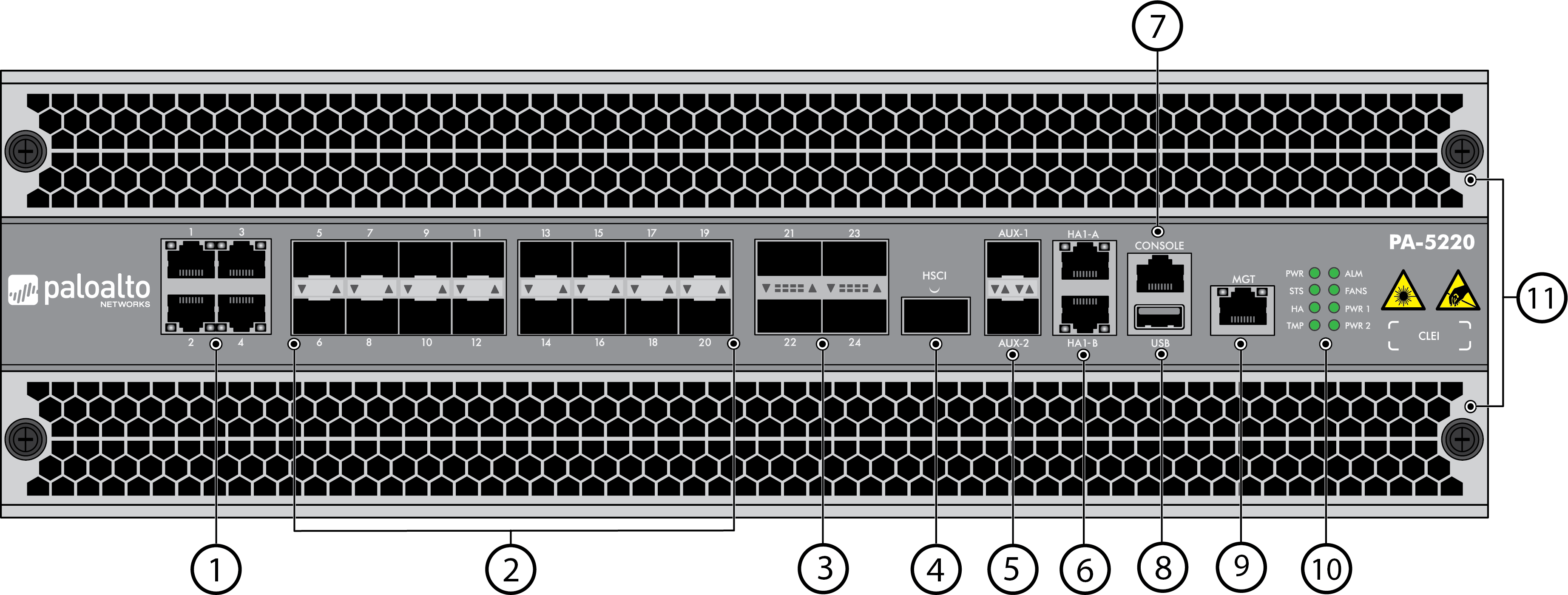PA-5200 Front Panel
Table of Contents
End.of.Sale (EoS)
Expand all | Collapse all
PA-5200 Front Panel
Learn about the PA-5200 firewall front-panel components.
The following image shows the front panel
of the PA-5200 Series firewall and the table describes each front
panel component. The only differences between the PA-5220 (shown),
PA-5250, PA-5260, and PA-5280 panels is the model name and the Ethernet
port speeds as described in the table.

| Item | Component | Description |
|---|---|---|
1 | Ethernet ports 1 through 4 | Four RJ-45 100Mbps/1Gbps/10Gbps ports for
network traffic. The link speed and link duplex are auto-negotiate
only. |
2 | SFP ports 5 through 20 | Sixteen SFP/SFP+ ports for network traffic. Each
port can operate as either SFP (1Gbps) or SFP+ (10Gbps) based on the
installed transceiver. |
3 | QSFP+ ports 21 through 24 | These ports vary depending on your firewall
model:
|
4 | HSCI port | These ports vary depending on your firewall
model:
|
5 | AUX 1 and AUX 2 ports | Use these SFP+ ports for HA1, management
functions, or log forwarding to Panorama. For information
on configuring the port, refer to the on-device Help content in DeviceSetupInterfaces or refer
to the PAN-OS 9.0 Web Interface Reference. |
6 | HA1-A and HA1-B | Two RJ-45 10/100/1000Mbps ports for high-availability
control (HA1). |
7 | CONSOLE port (RJ-45) | Use this port to connect a management computer
to the firewall using a 9-pin serial to RJ-45 cable and terminal
emulation software. The console connection provides access
to firewall boot messages, the Maintenance Recovery Tool (MRT),
and the command line interface (CLI). If your management
computer does not have a serial port, use a USB-to-serial converter. Serial
Settings Data rate: 9600 Data bits: 8 Parity:
none Stop bits: 1 Flow control: None |
8 | USB port | Use this port to bootstrap the firewall. Bootstrapping
enables you to provision the firewall with a specific PAN-OS configuration
and then license it and make it operational on your network. |
9 | MGT port | Use this Ethernet 10/100/1000Mbps port to
access the management web interface and perform administrative tasks.
The firewall also uses this port for management services, such as
retrieving licenses and updating the threat and application signatures. |
10 | LED status indicators | Five LEDs that indicate the status of the
firewall hardware components (see Interpret the LEDs on a PA-5200 Series Firewall). |
11 | Intake air filters | Two filters for air entering the firewall. Replace the Air Intake Filters on a PA-5200 Series Firewall every six
months. |
